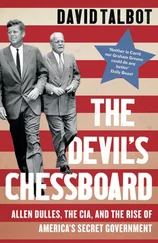David Grann - The Devil & Sherlock Holmes
Здесь есть возможность читать онлайн «David Grann - The Devil & Sherlock Holmes» весь текст электронной книги совершенно бесплатно (целиком полную версию без сокращений). В некоторых случаях можно слушать аудио, скачать через торрент в формате fb2 и присутствует краткое содержание. Жанр: Старинная литература, на английском языке. Описание произведения, (предисловие) а так же отзывы посетителей доступны на портале библиотеки ЛибКат.
- Название:The Devil & Sherlock Holmes
- Автор:
- Жанр:
- Год:неизвестен
- ISBN:нет данных
- Рейтинг книги:3 / 5. Голосов: 1
-
Избранное:Добавить в избранное
- Отзывы:
-
Ваша оценка:
- 60
- 1
- 2
- 3
- 4
- 5
The Devil & Sherlock Holmes: краткое содержание, описание и аннотация
Предлагаем к чтению аннотацию, описание, краткое содержание или предисловие (зависит от того, что написал сам автор книги «The Devil & Sherlock Holmes»). Если вы не нашли необходимую информацию о книге — напишите в комментариях, мы постараемся отыскать её.
comes this brilliant collection of true stories about people whose fixations propel them into unfathomable and often deadly circumstances.
Whether David Grann is investigating a mysterious murder, tracking a chameleon-like con artist, or hunting an elusive giant squid, he has proven to be one of the most gifted reporters and storytellers of his generation. In
, Grann takes the reader around the world, revealing a gallery of rogues and heroes who show that truth is indeed stranger than fiction.
The Devil & Sherlock Holmes — читать онлайн бесплатно полную книгу (весь текст) целиком
Ниже представлен текст книги, разбитый по страницам. Система сохранения места последней прочитанной страницы, позволяет с удобством читать онлайн бесплатно книгу «The Devil & Sherlock Holmes», без необходимости каждый раз заново искать на чём Вы остановились. Поставьте закладку, и сможете в любой момент перейти на страницу, на которой закончили чтение.
Интервал:
Закладка:
“Nobody wants their kid to go into it,” Jimmy Ryan told me later. “You’ll always hope they’ll find some kind of pencil job.”
“I grew up wanting to be a baseball player,” John Ryan said. “Then I dropped out of college, and one day my father came in the bar where I was working and said, ‘All right, mister, you want to bartend? Come with me.’ I’d never been in the hole before. I was scared. I won’t lie to you.”
“I can only imagine what he was thinking,” Jimmy Ryan said. “We try to help each other.”
John Ryan’s great-grandfather brought home only a few dollars a week from his work on the water tunnel; today, sandhogs earn as much as a hundred and twenty thousand dollars a year. Though many are descended from tramp miners, they now often emerge from the hog house in tailored suits, their hair perfectly combed, as if they were bankers or accountants. Chick Donohue, the head of the hog house, has a degree from the Kennedy School at Harvard and is well known in city politics. He wears his Harvard ring on one hand and his sandhogs’ union ring on the other. “That way, if I can’t outsmart ’em with the left, I hit ’em with the right,” he told me.
Just as sandhogs have gradually transformed the city, the city has gradually transformed the sandhogs. Some now arrive at the hole in a Cadillac or a BMW. John Ryan, who is engaged to be married, is buying a Colonial house in Nassau County. “A lot of guys are drawn to the money,” he admitted. He paused. “And there’s the camaraderie. That’s a big part of it, too.” He paused again, as if still searching for the deepest reason, then added, “Hell, I like it down there.”
After five years on the third water tunnel, John Ryan had risen to foreman. His current mission was to build the city’s newest “mole,” a two-hundred-and-thirty-ton drill that would be placed at his father’s site, on Tenth Avenue. Experimented with as early as the seventies, the mole was officially introduced in the water tunnels in 1992, and had become the sandhogs’ most critical instrument—comparable, in the world of tunnelling, to the invention of the printing press. In February, 2003, the latest mole was transported from New Jersey to Manhattan, in pieces weighing sixty to a hundred and thirty tons, on a flatbed truck; the payload was the largest ever to cross the George Washington Bridge. The components were then lowered into the Thirtieth Street hole by a special crane that could withstand the enormous weight.
One day in February, after the mole had been assembled in the tight confines of the tunnel, John Ryan invited me to go down with him and see it. The pipeline was twelve and a half feet in diameter. The mole had already been driven nearly half a mile, and to reach the heading we had to ride a railroad car called a “man trip,” which rattled from side to side. Groundwater seeped out of the surrounding rock, splattering against the walls as we sped past. After about five minutes, we came to a sudden stop. In the distance, I could see a monstrous machine that looked more like a space shuttle than a drill. The mole’s hydraulic engines churned, and its blinking lights gleamed. “Come on,” Ryan said excitedly, walking toward it. “That’s only the trailing gear.”
This gear—including a conveyor belt that carried out the crushed rock—took up most of the tunnel. A narrow gangplank had been built on the tunnel’s side. Occasionally, to pass one of the fifteen or so sandhogs, we had to turn sideways, pressing our faces against the damp rock. As we went deeper, the mole began to resemble a colossal organism: its giant cylindrical arms gripped the walls and pushed the machine’s mouth forward through the rock. In some compartments of the mole, engineers were peering at computer screens; the mole had lasers that registered the precise type of rock at the heading.
A siren sounded, and the men began to run up and down the plank. “What’s happening?” I asked nervously.
“Nothing,” Ryan said. “We’re just starting it up.”
The mole coughed and sputtered and shook. The temperature had been twenty degrees at the surface, but the mole heated the tunnel air to eighty degrees, and some of the men began to strip off their layers. After walking seventy-five yards, we reached the front of the mole: a round shield with twenty-seven cutters, each weighing three hundred and twenty pounds, pressed against the rock face, obscuring it completely. The cutters, driven forward by hydraulic propulsion, spun ferociously and noisily, chipping away at the granite, which was then carried out on the conveyor belt and loaded into muck cars. Ryan, who had grown up listening to tales of his forebears, said it was hard to believe that “my great-grandfather had only a goddam muck stick”—sandhog slang for shovel.
Indeed, until the mole was invented, tunnelling had changed only incrementally since the days of the Romans, who used fire and water to crack the rock and horses to carry it out. When a prototype of the mole was introduced in New York, in the seventies, many of the sandhogs feared it as much as they did caving rock.
“It’s like that old story about John Henry,” Chick Donohue explained, recalling the fabled contest between man and machine after the invention of the steam drill. “Well, when they introduced the first mole over in Brooklyn the cutters kept breaking, and the sandhogs would jump in with their shovels and picks. They knew they were competing for their jobs, and they were actually beating the mole! Of course, they then perfected the mole, and there was no contest.”
The construction of the first water tunnel required no fewer than eighty men to drill and blast for at least a week in order to advance a hundred feet. The mole, with a fraction of the manpower, can tunnel that far in a day.
Yet, even with the mole, the third water tunnel has already taken six times as long as either City Tunnel No. 1 or No. 2; some people think it won’t be completed, as scheduled, by 2020. “We should’ve been done with this thing twenty years ago,” Jimmy Ryan said. “But the city keeps fucking around.”
Conditions above ground have proved almost as difficult as those below. After the initial phase of a billion-dollar contract to build the tunnel was awarded to a consortium of companies, costs began to exceed estimates by the millions. When the city balked at the rising costs, the companies sued and the work stalled. Then, in 1974, when the city went bankrupt, construction was halted altogether. In all, nearly a decade was lost, and in 1981, with work proceeding only piecemeal and the ever-growing demand for water forcing the old tunnels to carry sixty per cent more capacity than intended, city officials were so desperate that they pleaded with the federal government to fund the project.
Meanwhile, charges began to surface that Tammany Hall–like machinations were contributing to the delays. The once vaunted Board of Water Supply, which oversaw the construction, had become a “Democratic patronage plum tree,” as one critic put it. Stanley M. Friedman, the Bronx Democratic power broker who was later convicted of racketeering, was given a lifetime position on the board, with a salary of twenty thousand dollars, as well as an office, a secretary, a chauffeured car. “When I came in as mayor, it was a lifetime job given to retiring politicians,” Koch told me. “They didn’t do anything.”
The board was dismantled. But in 1986 the man in charge of supervising purchasing for the water tunnel at the D.E.P., Edward Nicastro, warned that contracts were still not being properly monitored. “You’d be amazed at how easy it is to steal in the system,” he told a reporter at the time.
In recent years, the greatest delays seem to be caused not by efforts to defraud the public but by attempts to placate it. Where the old water board once plowed over communities, the D.E.P. is now impeded by them. In 1993, when it tried to sink a shaft on East Sixty-eighth Street, Councilman Charles Millard protested that his office had received calls from parents whose children were “finding it difficult to concentrate.” NUMBY, or “not under my back yard,” movements sprang up. In 1994, after engineers had spent two years planning a new shaft site, residents in Jackson Heights held a protest, carrying signs that said, “DON’T GIVE US THE SHAFT.” Engineers were forced to find a new location. “When we want to choose a shaft site, everyone says, ‘Oh, the water system is a miracle, but please find another place,’ ” Ward told me. “ ‘We’re building a co-op’—or hotel or park—‘there.’ ” A D.E.P. engineer and geologist, Scott Chesman, added, “Instead of taking seven years to finish, we’re on thirty years, and hardly any of it’s been done. It’s like the eighteen-hundreds again.”
Читать дальшеИнтервал:
Закладка:
Похожие книги на «The Devil & Sherlock Holmes»
Представляем Вашему вниманию похожие книги на «The Devil & Sherlock Holmes» списком для выбора. Мы отобрали схожую по названию и смыслу литературу в надежде предоставить читателям больше вариантов отыскать новые, интересные, ещё непрочитанные произведения.
Обсуждение, отзывы о книге «The Devil & Sherlock Holmes» и просто собственные мнения читателей. Оставьте ваши комментарии, напишите, что Вы думаете о произведении, его смысле или главных героях. Укажите что конкретно понравилось, а что нет, и почему Вы так считаете.











